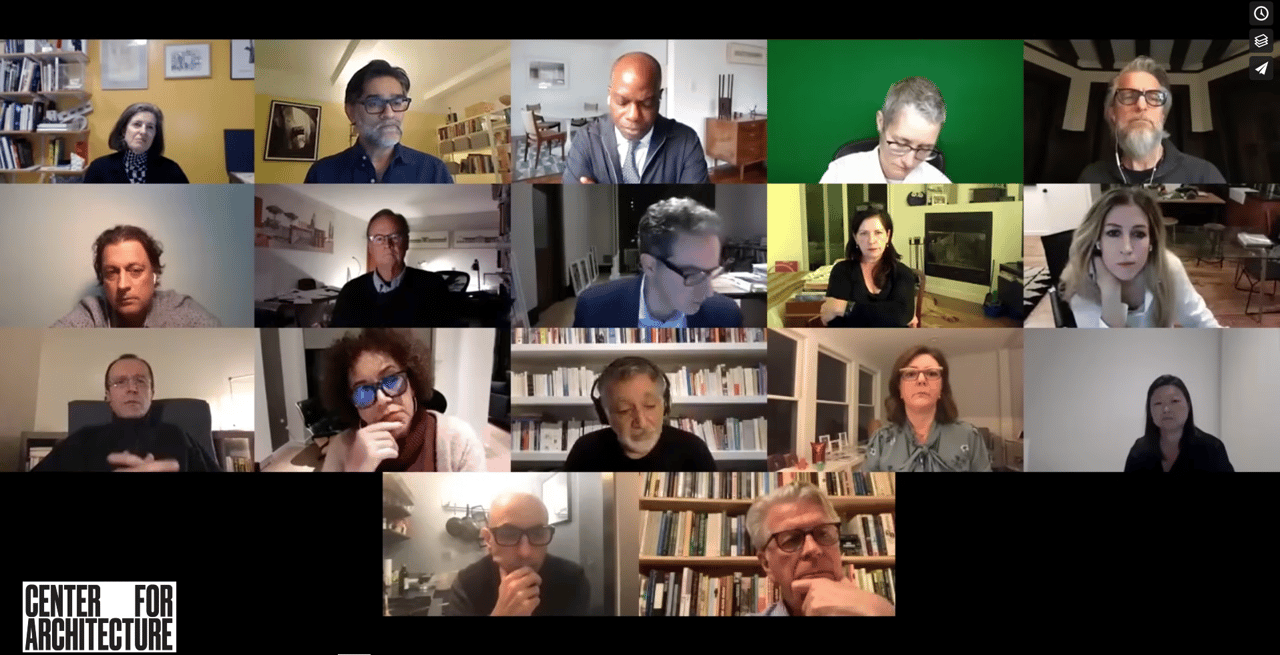
The Annual Dean's Roundtable sponsored by AIANY brings leaders of Northeast architecture schools together in conversation. The latest meeting, on November 6, 2020, was held online.
Image credit: Courtesy AIANY
FeatUre
Dean’s Roundtable
A Call for Political Change
By Stephen Zacks
Occurring during the coronavirus pandemic and the long night of a presidential election that would drag on for days, the 16th annual Dean’s Roundtable (watch the video here) took place fully online on a video meeting platform. With the Black Lives Matter protest movement in full swing and unrest in cities across the nation, the November 6 forum leaned heavily and with angst on questions of equity and access in architectural education.
Participants included 17 deans, associate deans, and chairs of architecture schools, including Milton Curry at University of Southern California as moderator and Sarah Whiting at Harvard Graduate School of Design, Hashim Sarkis at Massachusetts Institute of Technology, Meejin Yoon at Cornell, Maria Perbellini at New York Institute of Technology, Robert Kirkbride at Parsons The New School, Harriet Harriss at Pratt Institute, Robert Shibley at SUNY Buffalo, and Frederick Steiner at the University of Pennsylvania.
Leslie Lokko stood out as a particularly salient figure, having only two weeks earlier resigned as dean of the City College’s School of Architecture. Racism figured prominently in her reasons for leaving, and during the roundtable Lokko echoed the raw sentiments explained in her resignation letter, in which she noted an “absence of respect and empathy for Black people and Black women in particular.”
"What are you doing on the student part of the balance sheet, and what are we doing on the faculty side? Why aren’t we making more progress?”—Milton Curry
Midway through the discussion, Curry trained the group’s focus on the question. “Reckoning with legacies of exclusion, inequity, and systemic racism we’ve all experienced this past summer,” Curry said, “those at public institutions in California and Michigan have for a while been dealing with the vestiges of laws that severely constrain taking race into account in college admissions. And we’re all facing difficulty in sustaining pipelines of students and faculty who are specifically Black, Latinx, indigenous persons, and persons of color. What are you doing on the student part of the balance sheet, and what are we doing on the faculty side?” he asked the panel. “Why aren’t we making more progress?”
Shibley called for incentives that are explicit and real. He talked about a roller coaster at SUNY Buffalo in undergraduate enrollment numbers, which have gone from 3% to 20% and back down to 2% in the last 10 years. Four of their last 10 hires have been African-American, he said, but that required paying more for in-demand faculty, and the percentage of underrepresented minority faculty has ranged from 29% to 10%.
“If we are here tonight to crack open the golden egg on what constitutes a political challenge that could have traction, why do we not have politicians in our debate this evening?” —Harriet Harriss
Harriss acknowledged how much access in the first place—including her own to be appointed dean—comes from the advantages of being identified as white in a society structured around providing racial advantages and creating exclusionary barriers, historically and today, for Black, Latino, Asian, and other indigenous people. At the same time, she argued that architecture schools are not equipped to reverse these tendencies by themselves, while calling out the cost of education as one area they might be able to make a change, especially by lobbying for better policies and engaging policymakers. “That’s where I wish we could have a more pointed conversation,” Harriss said. “If we are here tonight to crack open the golden egg on what constitutes a political challenge that could have traction, why do we not have politicians in our debate this evening? Why not on the panel? Why didn’t we even invite them? Where is the mandate that we present to politicians to be the voice of that change?”
Lokko brought the challenge to a critical climax, pointing to the pervasive meritocratic assumptions that govern higher education. We act as if hard work and special talent accounts for professional success, she observed, yet movement politics in recent years has reminded us over and over again of the structural advantages and disadvantages that track with racial discrimination—along with the still less-discussed disadvantages of poverty for members of any group. “One of the biggest difficulties in the U.S. is the conundrum that is literally at the heart of this society, which is the impossibility of squaring the myth of meritocracy with the reality of enslavement,” Lokko said. “Those two things are incompatible. Until institutions are willing to acknowledge that incompatibility and to go to those places—those deeply uncomfortable, painful, challenging places—we will never square this.”
Lokko implied that the struggle for change put her at odds with tenured faculty unwilling to institute change and an inability to bring in new faces. “In South Africa, the one body that was able to take the canon and turn it inside out were the young faculty,” she said, suggesting that adjuncts might be able to play a bigger role. “In a system that is as heavily regulated and tenured as this, it is almost impossible to do that. If people are looking for radical change, it’s not going to come from the people who have the most to lose. The conversations can go around this endlessly, but to me it’s the structural issues that preclude any kind of meaningful change.”
